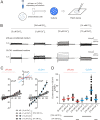Secreted CLCA1 modulates TMEM16A to activate Ca(2+)-dependent chloride currents in human cells
- PMID: 25781344
- PMCID: PMC4360653
- DOI: 10.7554/eLife.05875
Secreted CLCA1 modulates TMEM16A to activate Ca(2+)-dependent chloride currents in human cells
Abstract
Calcium-activated chloride channel regulator 1 (CLCA1) activates calcium-dependent chloride currents; neither the target, nor mechanism, is known. We demonstrate that secreted CLCA1 activates calcium-dependent chloride currents in HEK293T cells in a paracrine fashion, and endogenous TMEM16A/Anoctamin1 conducts the currents. Exposure to exogenous CLCA1 increases cell surface levels of TMEM16A and cellular binding experiments indicate CLCA1 engages TMEM16A on the surface of these cells. Altogether, our data suggest that CLCA1 stabilizes TMEM16A on the cell surface, thus increasing surface expression, which results in increased calcium-dependent chloride currents. Our results identify the first Cl(-) channel target of the CLCA family of proteins and establish CLCA1 as the first secreted direct modifier of TMEM16A activity, delineating a unique mechanism to increase currents. These results suggest cooperative roles for CLCA and TMEM16 proteins in influencing the physiology of multiple tissues, and the pathology of multiple diseases, including asthma, COPD, cystic fibrosis, and certain cancers.
Keywords: biophysics; calcium activated chloride channels; cell biology; chronic inflammatory airway disease; human; ion channel regulation; structural biology.
Conflict of interest statement
The authors declare that no competing interests exist.
Figures






Similar articles
-
Modulation of TMEM16A channel activity by the von Willebrand factor type A (VWA) domain of the calcium-activated chloride channel regulator 1 (CLCA1).J Biol Chem. 2017 Jun 2;292(22):9164-9174. doi: 10.1074/jbc.M117.788232. Epub 2017 Apr 18. J Biol Chem. 2017. PMID: 28420732 Free PMC article.
-
Modulation of TMEM16B channel activity by the calcium-activated chloride channel regulator 4 (CLCA4) in human cells.J Biol Chem. 2024 Jul;300(7):107432. doi: 10.1016/j.jbc.2024.107432. Epub 2024 May 31. J Biol Chem. 2024. PMID: 38825009 Free PMC article.
-
TMEM16A channels generate Ca²⁺-activated Cl⁻ currents in cerebral artery smooth muscle cells.Am J Physiol Heart Circ Physiol. 2011 Nov;301(5):H1819-27. doi: 10.1152/ajpheart.00404.2011. Epub 2011 Aug 19. Am J Physiol Heart Circ Physiol. 2011. PMID: 21856902 Free PMC article.
-
Bestrophin and TMEM16-Ca(2+) activated Cl(-) channels with different functions.Cell Calcium. 2009 Oct;46(4):233-41. doi: 10.1016/j.ceca.2009.09.003. Epub 2009 Sep 26. Cell Calcium. 2009. PMID: 19783045 Review.
-
The Emerging Role of Calcium-activated Chloride Channel Regulator 1 in Cancer.Anticancer Res. 2019 Apr;39(4):1661-1666. doi: 10.21873/anticanres.13271. Anticancer Res. 2019. PMID: 30952704 Review.
Cited by
-
Soluble mucus component CLCA1 modulates expression of leukotactic cytokines and BPIFA1 in murine alveolar macrophages but not in bone marrow-derived macrophages.Histochem Cell Biol. 2018 Jun;149(6):619-633. doi: 10.1007/s00418-018-1664-y. Epub 2018 Apr 2. Histochem Cell Biol. 2018. PMID: 29610986 Free PMC article.
-
CaMKII-mediated phosphorylation of GluN2B regulates recombinant NMDA receptor currents in a chloride-dependent manner.Mol Cell Neurosci. 2017 Mar;79:45-52. doi: 10.1016/j.mcn.2016.12.002. Epub 2016 Dec 18. Mol Cell Neurosci. 2017. PMID: 27998718 Free PMC article.
-
Intestinal mucus components and secretion mechanisms: what we do and do not know.Exp Mol Med. 2023 Apr;55(4):681-691. doi: 10.1038/s12276-023-00960-y. Epub 2023 Apr 3. Exp Mol Med. 2023. PMID: 37009791 Free PMC article. Review.
-
Ion channels as a therapeutic target for renal fibrosis.Front Physiol. 2022 Oct 5;13:1019028. doi: 10.3389/fphys.2022.1019028. eCollection 2022. Front Physiol. 2022. PMID: 36277193 Free PMC article. Review.
-
Phosphatidylinositol 4,5-bisphosphate (PIP2) and Ca2+ are both required to open the Cl- channel TMEM16A.J Biol Chem. 2019 Aug 16;294(33):12556-12564. doi: 10.1074/jbc.RA118.007128. Epub 2019 Jul 2. J Biol Chem. 2019. PMID: 31266809 Free PMC article.
References
MeSH terms
Substances
Grants and funding
LinkOut - more resources
Full Text Sources
Miscellaneous

